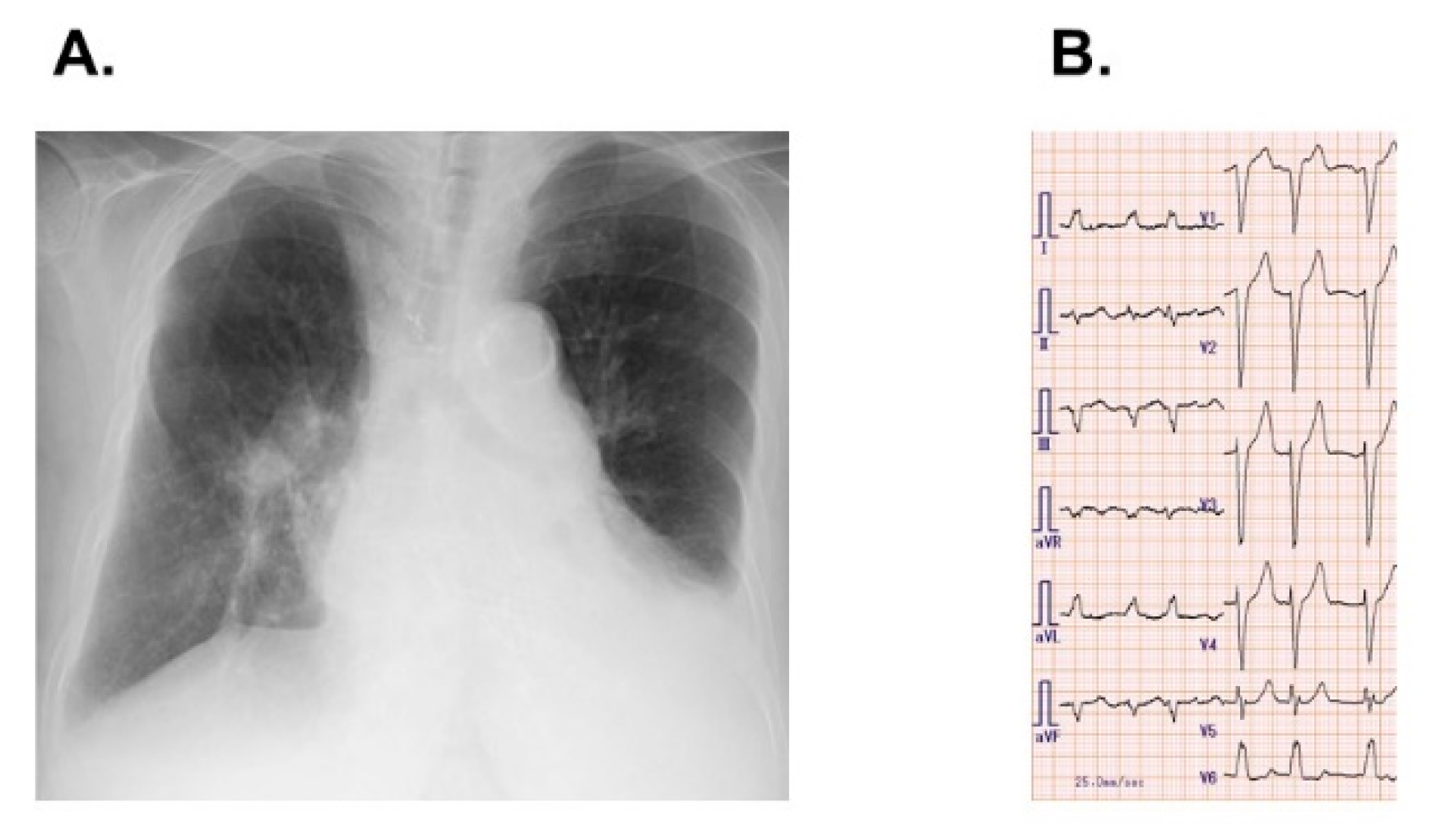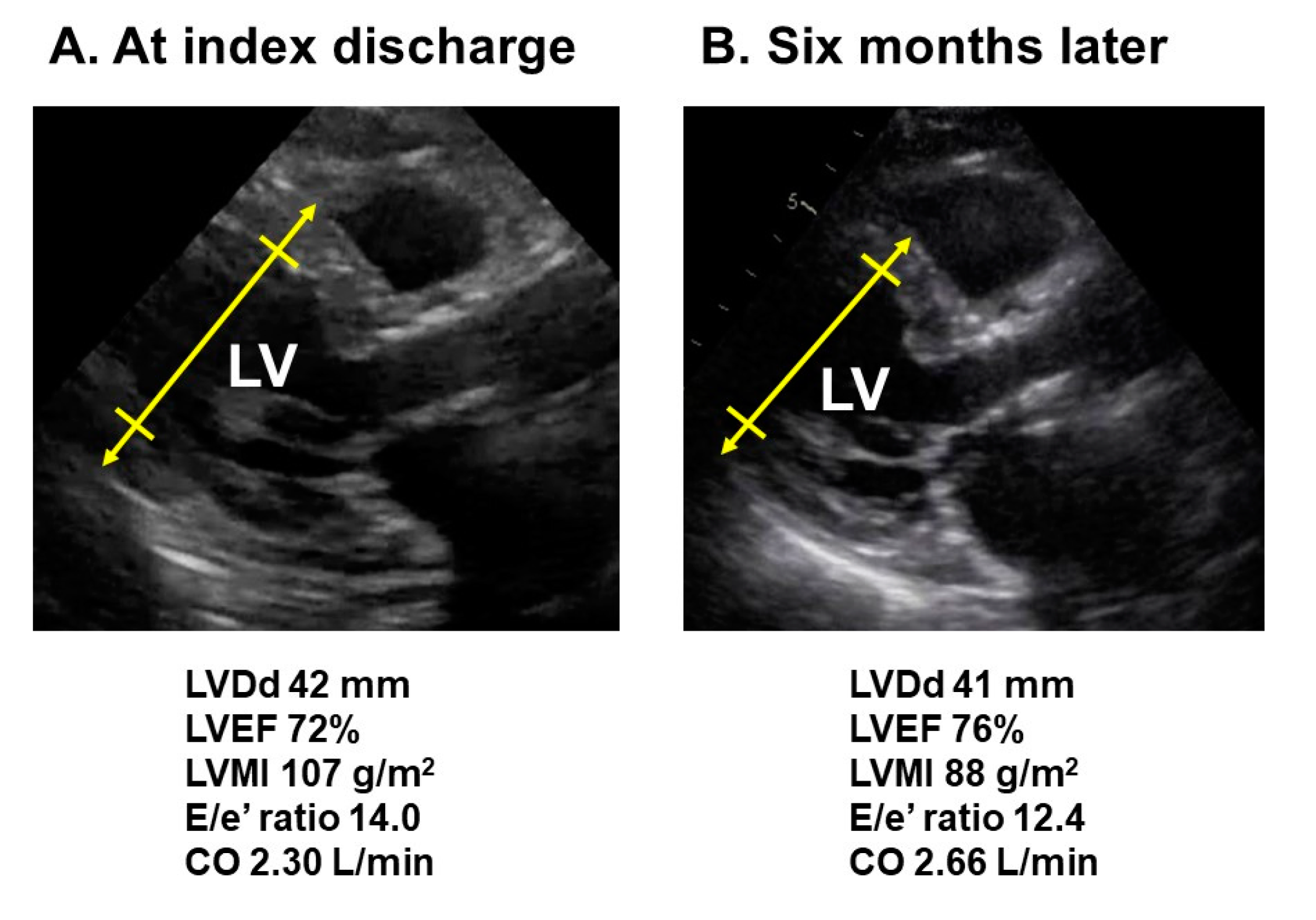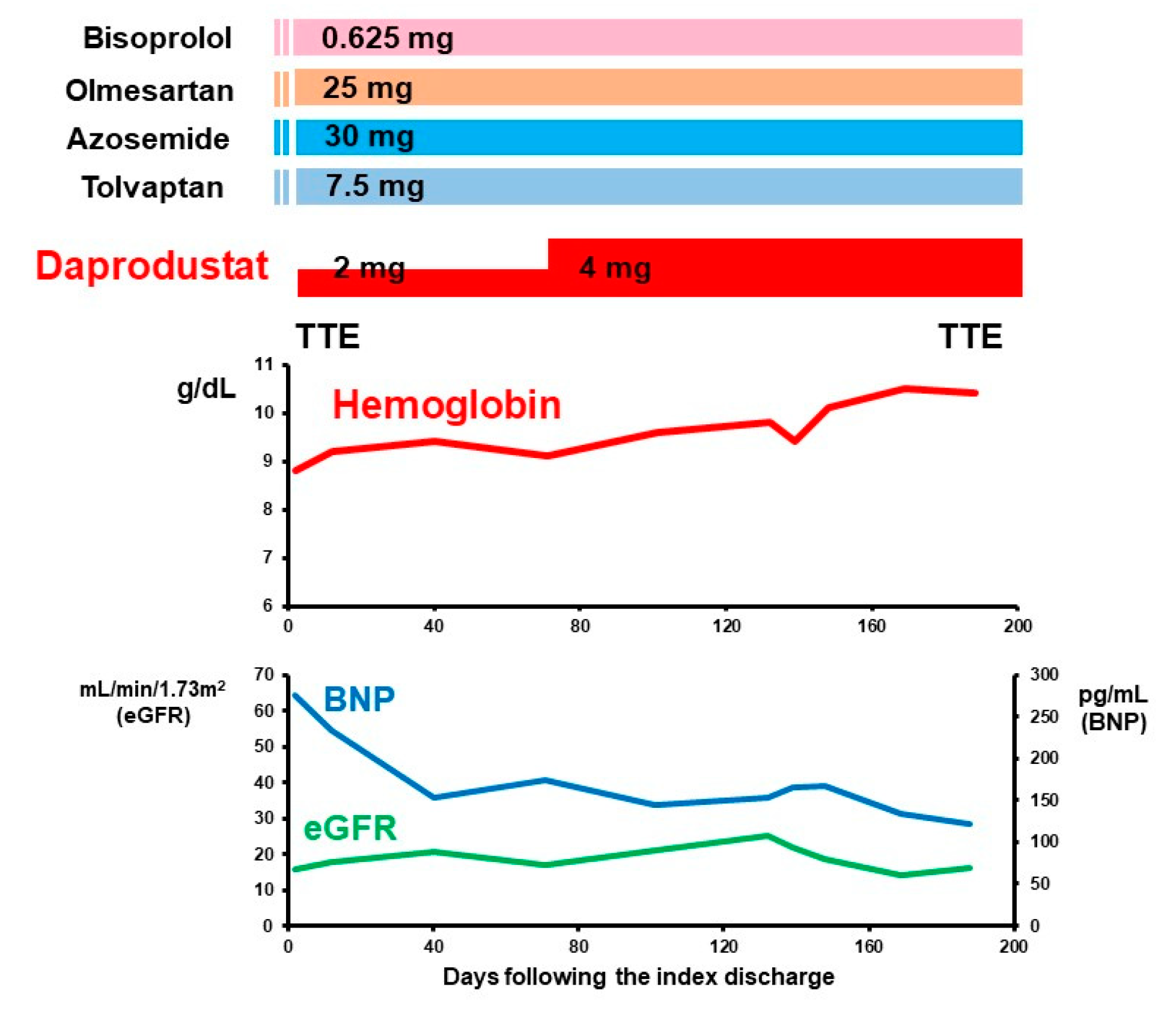Impact of Hypoxia-Inducible Factor Prolyl Hydroxylase Inhibitor on Heart Failure with Preserved Ejection Fraction
Abstract
:1. Introduction
2. Case Report
2.1. On Admission
2.2. In-Hospital Course
2.3. Post-Discharge Course
3. Discussion
3.1. Differential Diagnosis of Renal Anemia
3.2. Impact of HIF-PH Inhibitor on Cardiac Reverse Remodeling
4. Conclusions
Author Contributions
Funding
Institutional Review Board Statement
Informed Consent Statement
Data Availability Statement
Conflicts of Interest
References
- Silverberg, D.S.; Wexler, D.; Blum, M.; Iaina, A. The cardio renal anemia syndrome: Correcting anemia in patients with resistant congestive heart failure can improve both cardiac and renal function and reduce hospitalizations. Clin. Nephrol. 2003, 60 (Suppl. 1), S93–S102. [Google Scholar] [PubMed]
- Vlagopoulos, P.T.; Tighiouart, H.; Weiner, D.E.; Griffith, J.; Pettitt, D.; Salem, D.N.; Levey, A.S.; Sarnak, M.J. Anemia as a risk factor for cardiovascular disease and all-cause mortality in diabetes: The impact of chronic kidney disease. J. Am. Soc. Nephrol. 2005, 16, 3403–3410. [Google Scholar] [CrossRef] [PubMed] [Green Version]
- Silverberg, D.S.; Wexler, D.; Iaina, A. The importance of anemia and its correction in the management of severe congestive heart failure. Eur. J. Heart Fail. 2002, 4, 681–686. [Google Scholar] [CrossRef]
- Gupta, N.; Wish, J.B. Hypoxia-Inducible Factor Prolyl Hydroxylase Inhibitors: A Potential New Treatment for Anemia in Patients with CKD. Am. J. Kidney Dis. 2017, 69, 815–826. [Google Scholar] [CrossRef] [PubMed] [Green Version]
- Akizawa, T.; Nangaku, M.; Yonekawa, T.; Okuda, N.; Kawamatsu, S.; Onoue, T.; Endo, Y.; Hara, K.; Cobitz, A.R. Efficacy and Safety of Daprodustat Compared with Darbepoetin Alfa in Japanese Hemodialysis Patients with Anemia: A Randomized, Double-Blind, Phase 3 Trial. Clin. J. Am. Soc. Nephrol. 2020, 15, 1155–1165. [Google Scholar] [CrossRef] [PubMed]
- Cascio, M.J.; DeLoughery, T.G. Anemia: Evaluation and Diagnostic Tests. Med. Clin. N. Am. 2017, 101, 263–284. [Google Scholar] [CrossRef] [PubMed]
- Swedberg, K.; Young, J.B.; Anand, I.S.; Cheng, S.; Desai, A.S.; Diaz, R.; Maggioni, A.P.; McMurray, J.J.; O’Connor, C.; Pfeffer, M.A.; et al. RED-HF Committees and Investigators. Treatment of anemia with darbepoetin alfa in systolic heart failure. N. Engl. J. Med. 2013, 368, 1210–1219. [Google Scholar] [CrossRef] [PubMed] [Green Version]
- Pfeffer, M.A.; Burdmann, E.A.; Chen, C.Y.; Cooper, M.E.; De Zeeuw, D.; Eckardt, K.U.; Feyzi, J.M.; Ivanovich, P.; Kewalramani, R.; Levey, A.S.; et al. TREAT Investigators. A trial of darbepoetin alfa in type 2 diabetes and chronic kidney disease. N. Engl. J. Med. 2009, 361, 2019–2032. [Google Scholar] [CrossRef] [PubMed] [Green Version]



Publisher’s Note: MDPI stays neutral with regard to jurisdictional claims in published maps and institutional affiliations. |
© 2021 by the authors. Licensee MDPI, Basel, Switzerland. This article is an open access article distributed under the terms and conditions of the Creative Commons Attribution (CC BY) license (https://creativecommons.org/licenses/by/4.0/).
Share and Cite
Imamura, T.; Hori, M.; Tanaka, S.; Kinugawa, K. Impact of Hypoxia-Inducible Factor Prolyl Hydroxylase Inhibitor on Heart Failure with Preserved Ejection Fraction. Medicina 2021, 57, 1319. https://doi.org/10.3390/medicina57121319
Imamura T, Hori M, Tanaka S, Kinugawa K. Impact of Hypoxia-Inducible Factor Prolyl Hydroxylase Inhibitor on Heart Failure with Preserved Ejection Fraction. Medicina. 2021; 57(12):1319. https://doi.org/10.3390/medicina57121319
Chicago/Turabian StyleImamura, Teruhiko, Masakazu Hori, Shuhei Tanaka, and Koichiro Kinugawa. 2021. "Impact of Hypoxia-Inducible Factor Prolyl Hydroxylase Inhibitor on Heart Failure with Preserved Ejection Fraction" Medicina 57, no. 12: 1319. https://doi.org/10.3390/medicina57121319
APA StyleImamura, T., Hori, M., Tanaka, S., & Kinugawa, K. (2021). Impact of Hypoxia-Inducible Factor Prolyl Hydroxylase Inhibitor on Heart Failure with Preserved Ejection Fraction. Medicina, 57(12), 1319. https://doi.org/10.3390/medicina57121319






